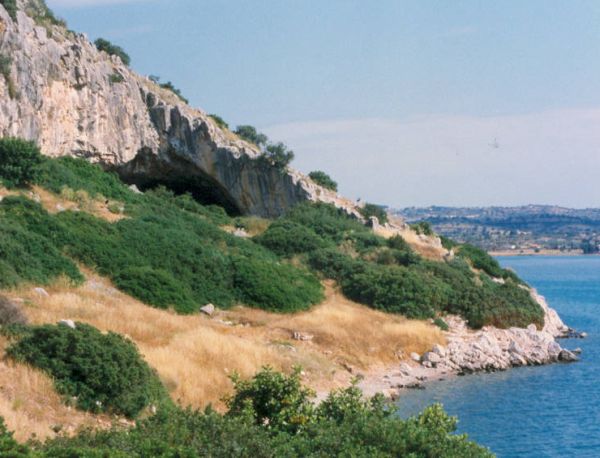- Franchthi Cave
Archaeological site
name = Franchthi Cave
name_local = Σπήλαιον Φράγχθι
|200px
caption_skyline = The entrance to the Franchthi Cave with the Paralia in the foreground. Facing south-east. Spring 1997.
country =Greece
region =Argolis
elevation = 5
peak_period =Mesolithic toNeolithic
lat_deg = 37
lat_min = 25
lat_sec = 24
lat_hem = N
lon_deg = 23
lon_min = 07
lon_sec = 56
lon_hem = EFranchthi cave (or Frankhthi cave, Greek: Σπήλαιον Φράγχθη) in the
Peloponnese , in the southeasternArgolid , is acave overlooking theArgolic Gulf opposite the Greek village ofKoilada .The cave was occupied from the
Palaeolithic c. 21,950 BC(and possibly earlier) through theMesolithic andNeolithic periods, being abandoned about 3000 BC (Middle Neolithic). It is one of the very few settlements in the world that shows continuous human occupation for more than 20,000 years.It also contains some of the earliest evidence for agriculture in Greece. Around 9,000 BC almonds, pistachios, bitter vetch and lentils all appear at the same time. None appear to be native to the region, two are certainly from Asia Minor. This would seem to indicate that the farming of legumes and nuts preceded that of grain, in Greece, if not Asia Minor at least. This would make this area the oldest known agricultural site in Greece.
Obsidian items from the cave have been traced to the island ofMelos 80 miles away by sea, which indicates long-distance sea travel. Around 6000 BC, evidence of domesticated animals and plants (emmer andeinkorn wheat ) appears in the archaeological record at the cave.References
*Farrand, William R. 1999. "Depositional History of Franchthi Cave", Fascicle 12: "Sediments, stratigraphy, and chronology". Bloomington, Indiana: Indiana University Press.
External links
* [http://www.mnsu.edu/emuseum/archaeology/sites/europe/franchthicave.html Archeological history of Franchthi Cave]
Wikimedia Foundation. 2010.
